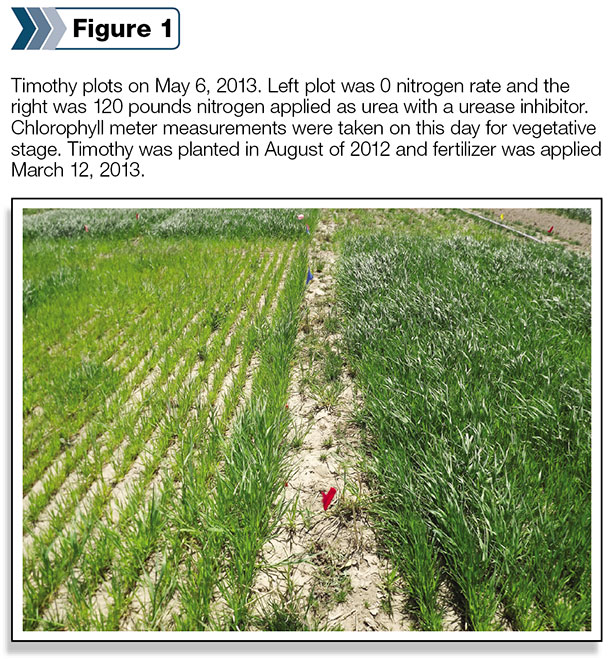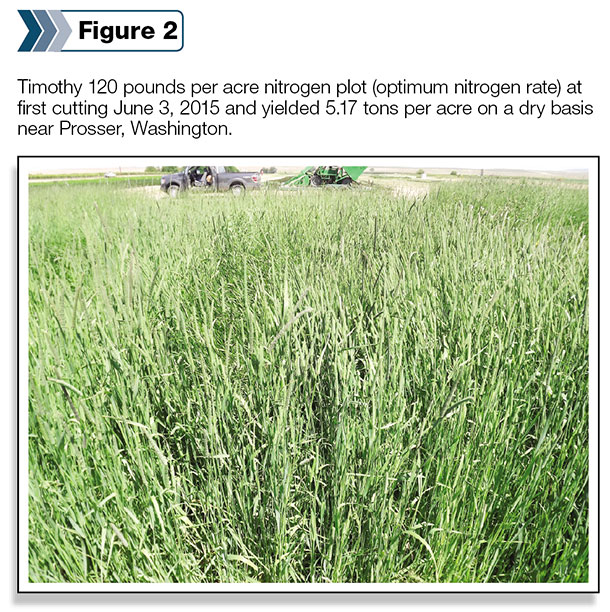Timothy hay is Washington state’s largest- and highest-valued grass hay commodity. Timothy hay in the Pacific Northwest is primarily grown for export to Japan to be used for feed in dairy herds. In the lower Columbia Basin, researchers have received yields up to 10 tons per acre per year in three cuttings, but most farmers get two cuttings and receive around 5 to 7 tons per acre per year.
Very little work has been done to determine optimum nitrogen rates for this important commodity in the U.S.; however, some work has been done in Canada. Since timothy’s root system only reaches 2 feet and most of the roots are in the first foot, recommendations for nitrogen and other nutrients will likely be different than other grass hay crops.
A team of Washington State Extension researchers came together to conduct research and develop a recommendation for timothy that would be both economical and environmentally sound.
Research was conducted at Prosser and Othello, Washington locations in 2013 and 2014. The team had two primary objectives: spring soil test recommendations and develop tools to determine need and rate of additional nitrogen to apply to maximize profit. Two in-season tools developed include a leaf tissue test and a chlorophyll meter test.
Optimum nitrogen fertilizer rates and spring soil test for first cutting
First-cutting timothy hay for export is harvested at anthesis stage (first heading). Timothy yield peaked around 5 tons per acre with 80 to 120 pounds nitrogen per acre treatment depending on the year.
Increased profit often is found when you can eliminate wasted fertilizer, and we hope these methods will help cut unnecessary costs. The optimum nitrogen fertilizer rate was dependent on soil nitrogen levels at the beginning of the season.
Before fertilizer application, soil was tested at 1-foot increments to determine how many pounds of nitrogen were available. We found an excellent relationship between pounds of soil nitrogen plus fertilizer (soil + fertilizer) with yield and maximum profit.
The profit calculation was based on a timothy hay price of $225 per ton and $0.50 per pound of actual nitrogen price for urea with a urease inhibitor. Our maximum yield, averaged across locations and years, was 5.25 tons per acre for first cutting and was consistently associated with soil + fertilizer at 190 pounds nitrogen per acre.
Maximum profit after considering fertilizer cost was soil + fertilizer at 170 pounds nitrogen per acre. The optimum nitrogen fertilizer treatment corresponded with a protein level of 9 percent in the hay at harvest.
What is a SPAD chlorophyll meter and how is it used?
Previous research has shown that on corn, the nitrogen status can be instantaneously assessed in the field using soil plant analysis development (SPAD) units to determine optimum fertilization. Our team set out to make the system work on timothy and use fertigation to correct deficiencies, since many of the fields are under center pivots.
Light can be broken down into different wavelengths – of which a part is in the visible spectrum; that is how we see colors – and is measured in nanometers (nm). Plants capture two wavelengths of light: the visible spectrum red and blue, and they reflect green light, which makes the plants appear green.
These two wavelengths of light are captured in chlorophyll molecules, which are part of the plants’ photosystems where photosynthesis occurs. If the chlorophyll molecules are short of nitrogen, they exhibit chlorosis (less green and, ultimately, yellowing occurs).
The SPAD meter measures how much red light at 650 nm is absorbed by the sample and how much transmission of infrared light (which is not visible) at 940 nm, at which no absorption occurs and gives a greenness measurement (SPAD unit).
These SPAD units are compared to an over-nitrogen-fertilized strip in the field and relative chlorophyll units (RCM) are calculated (field reading/overfertilized strip reading = RCM) with at least 20 measurements taken from both sites.
Results for relative chlorophyll measurements are related to the amount of chlorophyll in the samples tested, which is correlated with the nitrogen status of the plant – and ultimately the field if you test enough plants. Chlorophyll SPAD meters are commercially available from several suppliers.
Timing of in-season assessment is critical
The protocol for in-season nitrogen assessments and recommendations were developed for two growth stages. The first growth stage, and most accurate assessment, is when the timothy crop is vegetative and has a stem elongated 6 inches in length (RCM veg.; Figure 1).

The second assessment timing is when the stem is approximately 20 inches tall and coincides with timothy in early boot (RCM boot). In the Columbia Basin, this growth stage occurs in early May and is about a week apart. For both the chlorophyll and tissue testing, we used the newest-formed leaf that had a visible collar.
Both SPAD meter and tissue testing are now available for in-season assessment
Profit was maximized when using the SPAD meter 0.85 RCM at the vegetative stage. Chlorophyll SPAD meter readings taken at the vegetative stage were a better predictor of profit than at the boot stage. Profit was maximized at 0.87 RCM at the boot stage.
Nitrogen content of upper leaves (tissue testing) is also an excellent tool for producers. The optimum nitrogen concentration to maximize profit is 3.15 percent at the vegetative stage with stems 6 inches in length and 3.36 percent at the early boot stage when stems were 26 inches in length.

Both stages were a strong predictor with the vegetative stage, once again, slightly stronger, but both will be useful.
Since both chlorophyll and tissue tests were taken one week apart and differences existed, it is important to determine the correct growth stage when making a recommendation.
All three tools – spring soil test, chlorophyll meter (RCM) and leaf tissue testing – will assist farmers making decisions for in-season adjustments and beginning-season nitrogen fertilizer rates.
Calibration of the SPAD and fine-tuning tissue testing for other forage crops may help producers to be more profitable and environmentally sound in producing forage for livestock.
Sprinklers are an excellent method of making in-season nitrogen fertilizer adjustments at a low cost.
For more information on what nitrogen rates to put on with SPAD, tissue testing or more information on these tools, contact Steve Norberg. FG
This research was gratefully funded and supported by the Washington State Hay Growers Association, WSU BIOAg program and the International Plant Nutrition Institute. This material is being submitted for a blind, peer-reviewed scientific journal article.
Don Llewellyn is a regional livestock specialist with Washington State University – Kennewick. Email Don Llewellyn . Steve Fransen is a forage specialist with Washington State University – Prosser. Email Steve Fransen. Shannon Niebergs is an associate professor with Washington State University – Pullman. Email Shannon Niebergs.
Steve Norberg is a regional forage specialist at Washington State University – Pasco. Email Steve Norberg.









